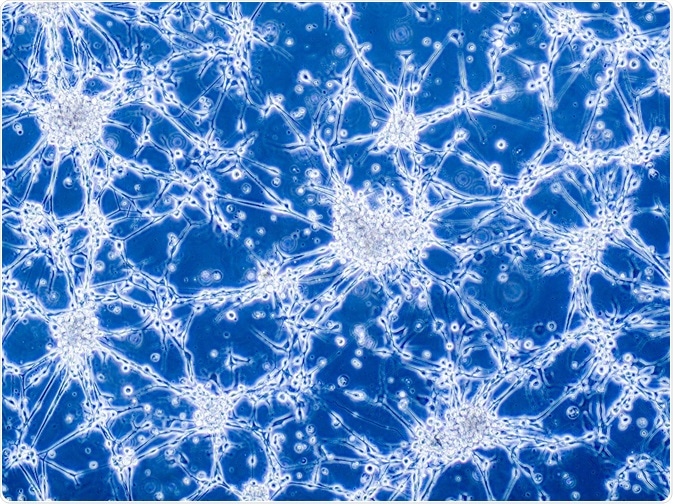By Gillian D’Souza, MSc
Immunoenzymatic staining of biological samples has grown to become a valuable tool for research and diagnostic purposes.

Credit: Anna Durinikova/Shutterstock.com
In many cases, researchers are faced with the need to detect two or more antigens in a single tissue specimen. The creates an issue called ‘colocalization’, where an antibody binds to multiple off-target antigens in a sample.
How does one achieve ideal sample staining without cross-reactions between different detection methods? Or how does one identify the best color combinations that provide adequate contrast between individual and mixed colors at the site of interest? Multiple staining techniques have been identified to address these challenges and immunoenzymatic chromogen staining is one such option gaining prominence.
What is immunoenzymatic chromogen staining?
Immunoenzymatic chromogen staining is an immunology staining technique used to visually detect two or more antigens in a single cell (colocalization). The technique relies on differences between primary antibodies such as mouse Ig isotypes or IgG subclasses or conjugates.
A chromogen is localized to a particular antigen of interest in fixed tissues via an antibody-antigen detection system. Following the antibody-antigen reaction, the chromogens appear as different colors under bright field microscopy. If the two antigens of interest are present in the same cellular compartment, colocalization is marked by a mixed color. When present in different cellular compartments, colocalization is usually observed as two separate colors.
The role of chromogens
The choice of chromogens in immunoenzymatic staining is crucial to ensure adequate visual contrast. In the case of colocalization, the primary goal is to achieve ideal contrast, between both the basic colors and the mixed component. Two of the most widely used chromogen combinations for double staining are red-blue (with a purple-brown intermediary color) and turquoise-red (with a purple-blue intermediary color).
The red-blue combination: consists of alkaline phosphatase (AP) activity and horseradish peroxidase (HRP) activity. The former (AP) appears blue with Fast Blue BB/ Napthhol-AS-MX-phosphate, while the latter can be seen as a red coloration using 3-amino-9-ethylcarbazole (AEC).
Given that both reaction products are soluble in organic mounting media, this combination requires aqueous mounting. A counterstain (such as methyl green) in combination with the red-blue colors must be tested per antibody combination.
The turquoise-red color combination: comprises beta-galactosidase (ß-GAL) activity and alkaline phosphatase (AP) activity. ß-GAL activity is seen as a turquoise coloration using 5-bromo4-chloro-3-indolyl ß-galactoside (X-gal) with ferro-ferri iron cyanide salts, while AP activity is observed as a red color using Fast Red TR or Fast Red Violet LB/Naphthol-AS-MX-phosphate.
Immunoenzymatic staining vs immunofluorescence
Both immunofluorescence (IF) and immunoenzymatic staining are examples of multiple staining techniques in immunology. Despite its accuracy being well established, immunofluorescence comes with some well-known limitations: quenching (decreasing intensity) of the fluorescence signal at excitation, fading of the fluorescence signal when samples are stored at room temperature, and autofluorescence which occurs as a result of formaldehyde fixation.
In contrast, immunoenzymatic chromogen staining not only allows for easy microscopic observation with the unaided eye, but also ensures that the stained tissue section is permanently fixed, with its staining quality maintained for several years. Several investigators and researchers therefore prefer immunoenzymatic staining over immunofluorescence.
In recent years, various tool kits have been developed to reduce challenges researchers face with immunoenzymatic chromogen staining. This includes easier antibody conjugation techniques and the use of various chromogenic substrates that are more stable in nature. It is hoped that as immunoenzymatic staining procedures evolve, so will such techniques – making substrate preparation easier and reducing the length of staining procedures.
Sources:
- Chris M van der Loos. ‘Multiple Immunoenzyme Staining: Methods and Visualizations for the Observation With Spectral Imaging.’ Journal of Histochemistry and Cytochemistry, 2008. 56(4):313-28
- Chris M. van der Loos. ‘Chromogens in Multiple Immunohistochemical Staining Used for Visual Assessment and Spectral Imaging: The Colorful Future.’ The J Histotechnol 33(1):31–40, 2010.
- Shenna L. Washington et al, ‘Multicolor Enzymatic Immunohistochemistry Assays for FFPE Tissue.’ BioTechniques, Vol. 56, No. 6, June 2014, pp. 334–336
Further Reading